Heroes Of The Great War: World War I Comes to Kickstarter [Part Two]
May 8, 2017 by oriskany
Good morning, Beasts of War, and welcome to Part Two of our review of Heroes of the Great War: Limanowa 1914, presented by Gladiator Games.
Check Out The Kickstarter
For those of us just joining us, the first part of this review can be found HERE, but for now, let’s continue our explorations of this highly recommended new historical wargame.
A Closer Look At The Rules
In many ways, Heroes of the Great War is like most other wargames. Players move units across a battle map (in this vase a hex grid) and engage in combat with enemy units. The objective is either to destroy the enemy’s force, or capture a certain number of objective hexes (towns).
What makes the game a little different is that these units represent large units of thousands of men, and each hex is many miles across. So movement rates and attack ranges might be much smaller than many players are used to. Also, units cannot usually move and attack in the same turn. They must begin the turn within reach of their target.
Furthermore, players can only move a certain number of units per turn. I think these constraints are designed to simulate limitations of logistics, communications, and transport in 1914 armies, without additional complications of “supply points” or other bookkeeping.
While these constraints may seem restrictive, they actually add a great deal to the game. Players have to think very carefully about their actions, often several turns in advance. Also, there are ways to mitigate these restrictions, such as massing attacks on specific strategic points, coordination with artillery support, and careful use of battle cards.
Speaking of artillery, the “big guns” play a massive role in this game (as you’d expect in World War I). Putting batteries on high ground and coordinating with observers increases effectiveness. Players can also choose whether the artillery will simply destroy enemy units, or provide an overall support bonus in larger, combined arms attacks.
Movement is pretty slow in this game, wholly appropriate for units that have to walk everywhere they go (either on foot or horseback). Roads can help speed things along, but of course, this makes attack paths predictable. Railroads also play a big role, but of course, a rail network can only carry so much traffic.
Heroes of the Great War: Limanowa 1914 has a quick, clean combat resolution system that, while retaining an element of risk, also keeps results fairly predictable and non-random. This is crucial in a game where such long-range planning is necessary. The terrain in a hex can also have a big effect on the outcome of combat.
Units also take incremental or “step” damage. Remember these pieces can be brigade or divisions of thousands of men. They don’t disappear on one big explosion. Damaged units can continue to hold the line or press an attack, depending on how hard you want to push your luck.
Another feature found in the game is how attacking units will almost always risk taking at least some damage in return. These are thousands of men attacking thousands of other men, even an overwhelming and successful assault will suffer at least some casualties, a factor that needs to be taken into account as you plan your campaign.
Assembling The Armies
Heroes of the Great War: Limanowa 1914 includes a wide variety of unit types from which the armies of the two empires are built. Not only does this add a tremendous amount of tactical depth and nuance to the gameplay, but also drenches the game in rich historical texture.
Both sides have infantry, cavalry, and artillery units. But these are just your base or “core” units. The advanced rules also bring in the generals who commanded these armies, with their own “personal” units and abilities. Both sides also have special “elite” units in all these categories, each with their own special combat abilities and game values.
For example, both sides have “elite” artillery, which is heavier gun batteries with bigger attack values, additional options, or even longer range than other guns. Both sides also have “elite” machine gun units, which get preventative attacks that can break up enemy assaults on their position before they are carried through.
The Tsarist Russians also have “Guards” infantry to their army, which gets an extra (and usually bloody) bayonet charge in each assault, already formidable due to higher attack values. Cossack Cavalry has a “do-or-die” all-out attack option, allowing a sizable bonus to their attack if they accept a reciprocal penalty to their defence.
The Austro-Hungarian Army also presents its share of elite units. Hussar cavalry gets much the same special rules and bonuses as Cossacks do. Their elite infantry, however, is the Polish Legion, who get a sizable defence bonus because they are helping defend their Galician homeland.
Trying The Game
Of course, the first thing I did after receiving the demo game and reading the rules was set up a few “scrimmage” solitaire games just to get a feel for how the rules actually played out on the table. This complete, I set up some live games with BoW community members @gladesrunner (Jennifer) especially and @aras (Alex).
Some of you may remember Alex as the BattleTech player who helped Jennifer put my Clan Ghost Bear ‘mechs to such ignominious defeat in a previous article series. Well, Alex and I have been playing hex-and-counter games for years now, so I was particularly interested in getting his take on this game as well.
For our largest play-through the of the game, Alex took the two Russian corps and I played the two Austro-Hungarian groups (remember this game is originally designed for four players, although solitaire, 2-player, 3-player, and cooperative modes are also developed).
Things started well for me. In the north-west near Limanowa, I was able to savage Alex’s attacking Russians as they pushed across the open farmland toward my mountains. With my batteries of 1875M and 1905M rapid-fire artillery (with observers) in the mountains, I was able to shell almost any attack without mercy.
Even when his Guards and line infantry did reach my line, the stalwart defence of my Polish Legion (with machine guns also in the hills) ensured he made no progress other than his casualty count. Meanwhile, my Hussar cavalry began to flank him, especially to the south, soon driving toward objectives like Neu Sandez (Nowy Sącz today).
In the south, meanwhile, near Bártfa (modern Bardejov), I was able to get a little more aggressive. I soon had a foothold in Bártfa itself and managed to clear both hexes of the town after a bloody battle. Attacks on my flank, meanwhile, were handled by mountain artillery and counterattacks by my “Uhlan” line cavalry.
Of course, we were just getting started. One thing that wasn’t going well was the progress of my reinforcements from Krakow (tracked on an appendix chart attached to the main board). Please return next week for the last part in this article series, when we reveal the final outcome of the epic game!
We hope you’ve enjoyed this second look at Heroes of the Great War: Limanova 1914. We’ll be back next week for a look into the advanced rules in the game, wrap up of the playtesting undertaken with Alex, and summarise our conclusions on this Kickstarter project.
I hope you’ll take a moment to drop a comment below. Tell us what you thought of the article, the game, and whether you’ll be giving this a look on Kickstarter. Best of all, give us your thoughts on World War I in the East, and how it contrasted with the more infamous experience in the trenches of the West.
I cannot recommend strongly enough that you take a moment to look at this Kickstarter. It brings to light a whole new level of wargaming, in a theatre of war that is too often overlooked, with a great production quality.
Check Out The Kickstarter
If you would like to write an article for Beasts of War then please contact us at [email protected] for more information!
"What makes the game a little different is that these units represent large units of thousands of men, and each hex is many miles across..."
Supported by (Turn Off)
Supported by (Turn Off)
"Best of all, give us your thoughts on World War I in the East, and how it contrasted with the more infamous experience in the trenches of the West..."
Supported by (Turn Off)

































![TerrainFest 2024! Build Terrain With OnTableTop & Win A £300 Prize [Extended!]](https://images.beastsofwar.com/2024/10/TerrainFEST-2024-Social-Media-Post-Square-225-127.jpg)







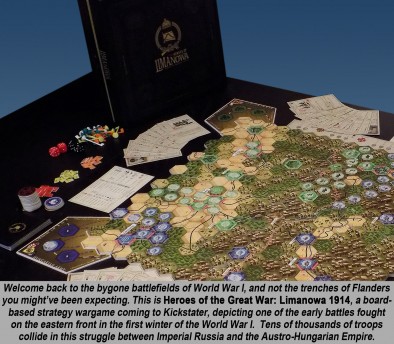
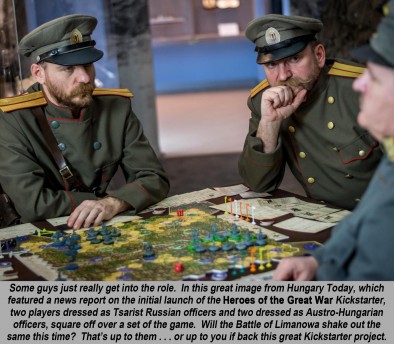
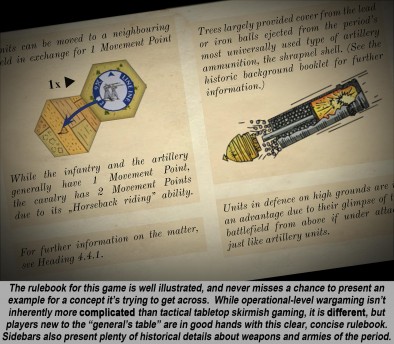
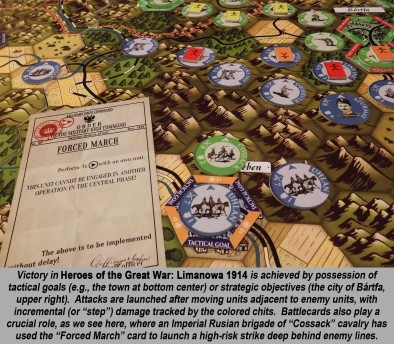
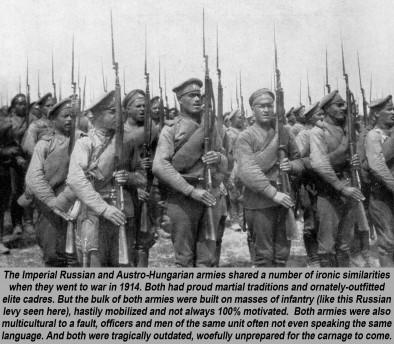
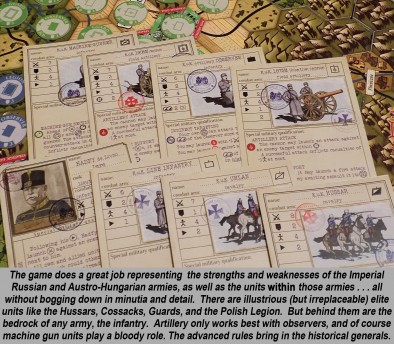
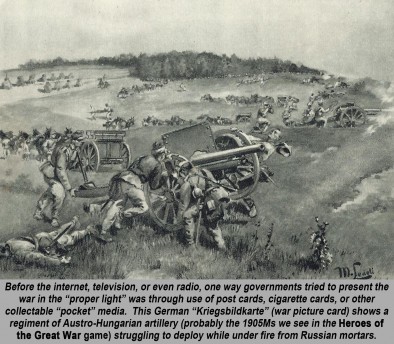
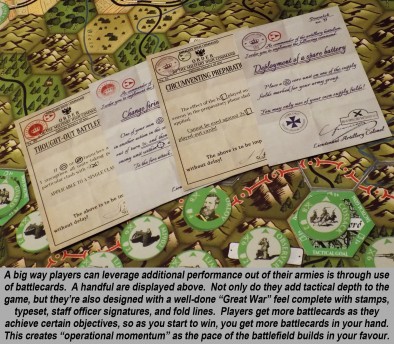
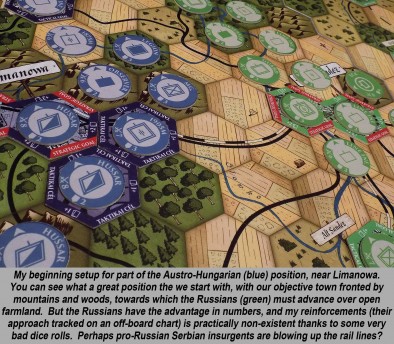


































Look forward to the next one, and to getting my hands on the game
Thanks for kicking us off again, @rasmus – Yep, our next part closes out the series, and we see how this game between me and @aras and closes out. 😀
Spoiler alert, got my ass handed to me until I got the hang of the rules.
Awesome icon for your account, dude. 😀 I’m sure @warzan would also approve of the StuG!
You seem to have synchronised them with my morning coffee 🙂
Yeah, @rasmus – they usually go up around noon GMT, so 7:00 am our time (or are you in central time?)
I am not sure I will invest in this, but would play this, if given the opportunity (not so subtle hint @oriskany next time you make the trip over bring it with you 😉 )
@commodorerob – I’ll see what I can do. 😀 I’ve already been asked to bring Panzer Leader or Arab-Israeli Wars for @davebpg . I guess the solution is to get over to that side of the water more often. 😀
Or just move over to this side of the Atlantic…lol
I am NOT starting apolitical discussion…but lets just say if things get too bad over here thanks to our…cough…cough….I guess we have to call him…uhhh…president… I could see me encouraging that choice 🙂
Oh man, let’s not get started on that. 😀 But I wold agree we have to drum up more historical content and support on BoW so we can have more historical-themed events in Ireland, evens which I would almost have to attend, right?
Thanks for the comment! 😀
Time to start a commune in Ireland – living of the games, not the land ….
Count me in. ..
@rasmus – Let’s call it “GameHenge” like Stonehenge but for gamers.
“Maybe “Mini-Henge” or “Hex Henge.” 😀
Good morning, everyone!
Here is the link to the actual Kickstarter page – I highly encourage everyone of the BoW community to check it out and give this game some serious consideration.
https://www.kickstarter.com/projects/2038926808/heroes-of-the-great-war-limanowa-1914-0/
#117, at your service sir
I can’t wait to see if anyone actually paints the miniatures. Maybe in the “cell-shading” technique we’ve seen on BoW. 😀
Those guys in the first picture really get into their war gaming! Where were all the uniforms at boot camp?
Thanks for the details about the game with added historical facts. Many times, game review just say “fun”, “too much work”, etc. These articles are very specific so you car honestly decide if this is for you.
Do you not remember at the TY one I had my Soviet Cap and Coat….lol
Right? The TY Boot Camp had all kinds of people in gear, including @brucelea ‘s Soviet Navy (?) striped shirt, yourself with the cap and coat, and of course Lewis @wittmann007 with the full GRU gear. 😀
Just a pedantic nit pick, I am a well know grammar 1930’s German political movement but ‘layers move units across a battle map (in this vase a hex grid)’ Can you put flowers in the vase?
Thanks for he nitpick! And since one good turn deserves four more … 1) I think you might have meant to say “well-known” instead of “well know.” 2) Pretty sure “well-known” should by hyphenated, since it’s applied here as a modifier to the object “German political movement” – as opposed, say “It is well known that Europe gave rise to many dangerous political movements in the 1930s.” 3) From what I can tell, “nitpick” is one word, not two. 4) When pluralizing (or “pluralising” depending on what side of the water we’re on) “1930s” – an apostrophe is not required… Read more »
sound like a interesting game splitting army’s so you hold with half and position with the rest.
That’s right, @zorg – in the early stages it can almost feel like two games are going, since this game was originally created as a four player, two-on-two game. You can certainly still play it that way, but there are also variants for 3- and 2-players, a solitaire version, and even a cooperative mode. 😀
The KS page probably explains it a lot better than I do. 😀
https://www.kickstarter.com/projects/2038926808/heroes-of-the-great-war-limanowa-1914-0/
the map and figures look fabulous definitely a game to look out for.
@zorg – They have a pretty cool video on their KS page as well:
https://www.kickstarter.com/projects/2038926808/heroes-of-the-great-war-limanowa-1914-0/
good to know.
You know a girl who is playing war games with cardboard counters?
Any pictures? 🙂
I should hope I know her. I’ve been living with her for 23 years. 😀
Never mind, sorry for the harmless little joke. 😉
What I would like to know in earnest, though, is if anybody was able to find historical background information about the battle and the personalities that took part in it. Even an Internet search did not yield many useful results.
Even more important, are there any colour drawings or pictures of the uniforms somewhere? Insignia and the like? The minis deserve to be painted, but we would need some info on how and which colours are the appropriate ones.
Hello!
@quipeccavit
We posted an update on Kickstarter. There you could learn more about the russian officers now 🙂
I won’t lie, when I was looking for some additional background photos, information, and maps to flesh out this review series, I found the pickings pretty slim on the web. But honestly, that was one thing I found great about this project. As opposed to other battles and campaigns that have been covered very heavily.
I did find some books that might useful to the serious hobbyist. Osprey can always be counted upon.
Early WW1 Austro-Hungarians:
https://www.amazon.com/Austro-Hungarian-Forces-World-War-Men-at-Arms/dp/1841765945/ref=sr_1_1?s=books&ie=UTF8&qid=1494462219&sr=1-1&keywords=The+Austro-Hungarian+Forces+in+World+War+I+%281%29%3A
Tsarist Russians:
https://www.amazon.com/Russian-Army-1914-18-Men-at-Arms/dp/1841763039/ref=pd_sim_14_8?_encoding=UTF8&pd_rd_i=1841763039&pd_rd_r=TH7WP0S08BFJ47DR8953&pd_rd_w=kMOAx&pd_rd_wg=PXsNN&psc=1&refRID=TH7WP0S08BFJ47DR8953
@quipeccavit
Hello!
We have prepared a historical booklet with all the information you mentioned. Officers curiculum, uniforms, weapons, armys, special units etc.
It will be a stretch goal. But anyways we will find a solution, to send them to the backers who need it.
Great news, @dome . 😀 Welcome to Beasts of War!
I personally like that part of creating something 🙂
Thany for the reviews, those are really great!